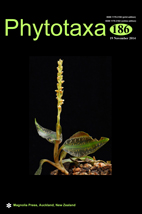Abstract
Phylogenetic analysis of the Auricularia auricula-judae complex was carried out using ITS and nLSU ribosomal RNA gene regions, and morphology of the A. auricula-judae complex and related species is examined based on 33 wild collections and 10 cultivated samples worldwide. The phylogenetic analysis presented here showed that the wild and cultivated samples previously identified as A. auricula-judae in China are different from those from Europe (the type locality). So far no exist name for the most important Chinese Auricularia species is available, and thus a new species, Auricularia heimuer, is described and illustrated. The new species is characterized by effused-reflexed or substipitate basidiomata with fawn to reddish brown color when fresh and vinaceous gray to dark gray when dry, pilose upper surface usually with a few folds when dry, short abhymenial hairs without branching and measured as 50–150 × 4–6.5 µm, usually presence of medulla, long clavate basidia with oil guttules and measured as 40–67 × 3.0–6.5 µm, and allantoid spores measured as 11–13 × 4–5 µm. A. auricula-judae is not found in China, and most probably has a distribution in Europe only. In addition, A. americana and A. villosula are the first time reported in China. Both A. heimuer and A. villosula grow on angiosperm wood, while A. americana is found on gymnosperm wood exclusively.

